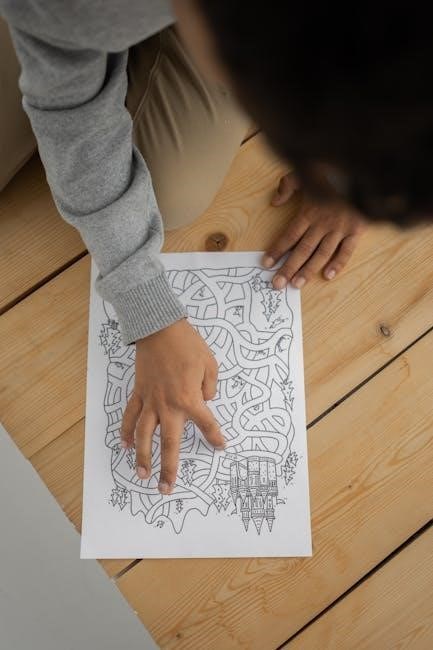The six trials of Jesus, spanning religious and civil proceedings, highlight the legal and spiritual significance of His journey to crucifixion, showcasing injustice and divine purpose․
1․1 Historical Context of the Trials
The six trials of Jesus occurred in Jerusalem during a volatile political and religious climate․ The Roman Empire governed Judea, while the Sanhedrin, led by the high priest, oversaw Jewish religious affairs․ Jesus’ teachings had angered religious leaders, who sought His execution․ The trials began with Annas, the former high priest, and proceeded through Caiaphas, the current high priest, before the Sanhedrin․ Roman involvement ensued, with Pontius Pilate and Herod playing roles․ These trials, though legally flawed, set the stage for Jesus’ crucifixion, fulfilling prophetic and redemptive purposes․
1․2 Purpose and Significance of the Trials
The trials of Jesus were a series of legal proceedings that, while aiming to condemn Him, ultimately revealed His divine nature and mission․ The religious leaders sought to eliminate Jesus as a threat to their authority, while the Roman authorities aimed to maintain political stability․ Despite the unjust processes, the trials fulfilled ancient prophecies and demonstrated Jesus’ innocence․ They also highlighted the spiritual conflict between light and darkness, setting the stage for His redemptive sacrifice, which offered forgiveness and salvation to humanity․

The Religious Trials
The religious trials involved Jesus appearing before Annas, Caiaphas, and the Sanhedrin, where Jewish leaders sought evidence to condemn Him, ultimately leading to a charge of blasphemy and setting the stage for further proceedings․
2․1 Jesus Before Annas (John 18:12-14, 19-24)
Jesus was first taken to Annas, the former high priest and father-in-law of Caiaphas, the current high priest․ Annas questioned Jesus about His disciples and teachings, seeking evidence to condemn Him․ Jesus responded by emphasizing the openness of His ministry, prompting Annas to send Him to Caiaphas․ This initial trial set the stage for further religious proceedings, highlighting the political and religious motivations of the Jewish leaders to silence Jesus through legal means, despite the lack of substantial evidence against Him․
2․2 Jesus Before Caiaphas and the Sanhedrin (Matthew 26:57-68; Mark 14:53-65; Luke 22:54)
After being sent by Annas, Jesus was brought before Caiaphas and the Sanhedrin, the Jewish high council․ The council sought false witnesses to accuse Him of blasphemy․ Jesus remained silent until Caiaphas directly asked if He was the Messiah․ Jesus affirmed His identity, leading Caiaphas to tear his robes, declaring blasphemy․ The Sanhedrin condemned Jesus to death, though the trial was legally flawed, occurring at night without a quorum․ This marked the second religious trial, driven by the leaders’ desire to eliminate Jesus as a threat to their authority and traditions․

2․3 Jesus Before the Sanhedrin (Matthew 27:1)
Early in the morning, the Sanhedrin reconvened to formally confirm the death sentence against Jesus․ This gathering was brief, as the council had already reached a verdict during the previous night’s secret meeting․ The Sanhedrin delivered Jesus to the Roman authorities, knowing only the Romans could execute Him․ This third religious trial solidified the Jewish leaders’ determination to eliminate Jesus, setting the stage for the civil trials under Roman jurisdiction․ The Sanhedrin’s actions were politically motivated, aiming to protect their power and maintain order under Roman rule․

The Civil Trials
Jesus faced three civil trials under Roman authority, involving Pontius Pilate and Herod․ These proceedings were marked by political maneuvering and injustice, ultimately leading to His crucifixion․
3․1 Jesus Before Pontius Pilate (Matthew 27:2, 11-14)
Jesus was brought before Pontius Pilate, the Roman governor, after the Jewish leaders accused Him of treason․ Pilate questioned Jesus about the charges but found no evidence of guilt․ Despite pressure from the Jewish leaders, Pilate sought to release Jesus, recognizing His innocence․ However, fearing a riot and yielding to their demands, Pilate ultimately sentenced Jesus to crucifixion, symbolically washing his hands to signify his disapproval of the verdict․ This trial highlighted the clash between Roman authority and Jewish religious accusations, showcasing Pilate’s internal conflict and the tragic outcome of injustice․
3․2 Jesus Before Herod (Luke 23:6-12)
When Pontius Pilate learned that Jesus was from Galilee, he sent Him to Herod Antipas, the tetrarch of Galilee, who was in Jerusalem for the Passover․ Herod, curious and seeking entertainment, questioned Jesus but received no response․ Despite the accusations, Herod found no basis for charges and mockingly dressed Jesus in fine robes before sending Him back to Pilate․ This encounter revealed Herod’s indifference to justice and his desire for spectacle, further illustrating the mockery of legal proceedings against Jesus․
3․3 Jesus Before Pontius Pilate Again (John 19:1-16)
After being sent back by Herod, Jesus appeared before Pontius Pilate again․ Pilate, seeking to appease the crowd, had Jesus scourged and presented Him as King of the Jews, hoping to evoke pity․ However, the Jewish leaders insisted on crucifixion, threatening to report Pilate to Caesar․ Despite declaring Jesus innocent, Pilate yielded to their demands, handing Jesus over for crucifixion․ This final encounter highlighted Pilate’s internal conflict and the Roman authorities’ ultimate compliance with Jewish pressures, sealing Jesus’ fate․

The Spiritual and Historical Significance of the Trials
The trials revealed the mockery of justice, emphasizing Jesus’ innocence and humanity’s guilt, while fulfilling divine purposes and showcasing the intersection of religious and political motivations․
4․1 The Mockery of Justice in the Trials
The trials of Jesus exposed the corruption and hypocrisy of both Jewish and Roman authorities․ False accusations, illegal proceedings, and biased judgments characterized the process․ Jesus faced false witnesses, and the trials violated Jewish and Roman legal standards․ Despite Pilate’s recognition of Jesus’ innocence, political pressure led to His condemnation․ The trials were not about justice but about fulfilling the agendas of those in power, revealing the deep moral and legal failings of the systems involved․
4․2 The Innocence of Jesus and the Guilt of Humanity
Jesu’ trials revealed His innocence, as no legal evidence supported the charges against Him․ Despite false accusations, He remained silent, fulfilling prophetic expectations․ The trials laid bare humanity’s guilt, as religious and political leaders conspired against Him, driven by fear and pride․ Jesus’ death symbolized the redemption of humanity’s sin, demonstrating divine love and forgiveness․ His innocence contrasted sharply with the corruption of those who condemned Him, highlighting the spiritual divide between God and a fallen world․

The Historical Context of the Trials
The trials occurred in 1st-century Judea, under Roman rule, marked by political and religious tensions․ The Sanhedrin and Roman authorities played pivotal roles in the legal proceedings․
5․1 The Role of the Sanhedrin and Jewish Leadership
The Sanhedrin, led by Caiaphas, played a central role in Jesus’ religious trials․ As the supreme Jewish council, they sought to maintain religious purity and authority, viewing Jesus as a threat to their power․ Annas, the former high priest, and Caiaphas, his son-in-law, orchestrated the initial interrogations․ The Sanhedrin convened illegally at night, violating Jewish legal standards, to secure a conviction․ Their actions were driven by political motives, aiming to eliminate Jesus to preserve their influence and avoid Roman intervention․ This set the stage for the eventual handover to Roman authorities․
5․2 The Involvement of Roman Authorities
The Roman authorities, particularly Pontius Pilate and Herod, played a pivotal role in Jesus’ civil trials․ Pilate, as the Roman governor, initially found no fault in Jesus but succumbed to pressure from Jewish leaders, sentencing Him to crucifixion․ Herod Antipas, who mocked Jesus, also participated in the trials․ Roman involvement was crucial, as Jewish leaders lacked the authority to impose capital punishment without Roman consent․ The trials underscored the political dynamics between Jewish and Roman powers, with Pilate balancing his judgment against the demands of the Jewish elite, ultimately yielding to their will despite recognizing Jesus’ innocence․

The Modern Relevance of the Six Trials
The six trials of Jesus offer timeless lessons on justice, forgiveness, and redemption, resonating with contemporary legal systems and personal spiritual journeys, emphasizing integrity and compassion․
6․1 Lessons for Contemporary Justice Systems
The six trials of Jesus expose profound injustices, offering lessons for modern legal systems․ His trials were marked by false accusations, biased judges, and mockery of due process, highlighting the importance of impartiality and fairness․ The illegal aspects, such as false witnesses and rushed proceedings, violated even Jewish law, underscoring the need for accountability and transparency․ These events remind us to uphold integrity, protect the innocent, and ensure justice is served without prejudice, providing timeless wisdom for contemporary judicial reforms and ethical decision-making․
6․2 The Enduring Message of Forgiveness and Redemption
The six trials of Jesus underscore His enduring message of forgiveness and redemption․ Despite facing unjust accusations and extreme suffering, Jesus prayed for His enemies, demonstrating unparalleled grace․ His response to injustice exemplifies the power of forgiveness, offering humanity a path to reconciliation․ The trials and crucifixion reveal God’s love and redemption, emphasizing that forgiveness transcends human wrongdoing․ This message remains central to the Gospel, inspiring believers to emulate Jesus’ compassion and mercy, even in the face of adversity, ensuring His legacy endures forever․
The six trials of Jesus reveal profound spiritual and historical significance, culminating in His crucifixion and resurrection, which remain central to Christian faith and redemptive purpose․
7․1 Summary of the Six Trials
The six trials of Jesus, including three religious and three civil proceedings, were marked by illegality and injustice․ Jesus was falsely accused by religious leaders, endured mockery, and faced Roman authorities like Pilate and Herod․ Despite His innocence, the trials culminated in His crucifixion, fulfilling divine purpose․ These events highlight the clash between human injustice and divine redemption, emphasizing Jesus’ forgiveness and love amidst suffering, which remains a powerful message for humanity․
7․2 The Eternal Impact of Jesus’ Trials and Crucifixion
Jesus’ trials and crucifixion remain a cornerstone of Christian faith, symbolizing redemption and forgiveness․ His endurance of injustice and suffering offers a universal message of love and sacrifice․ The events underscore the triumph of divine purpose over human oppression, inspiring countless believers across centuries․ The crucifixion’s legacy continues to shape theology, art, and culture, reminding humanity of the transformative power of grace and the promise of eternal life through Jesus’ ultimate sacrifice;




































































